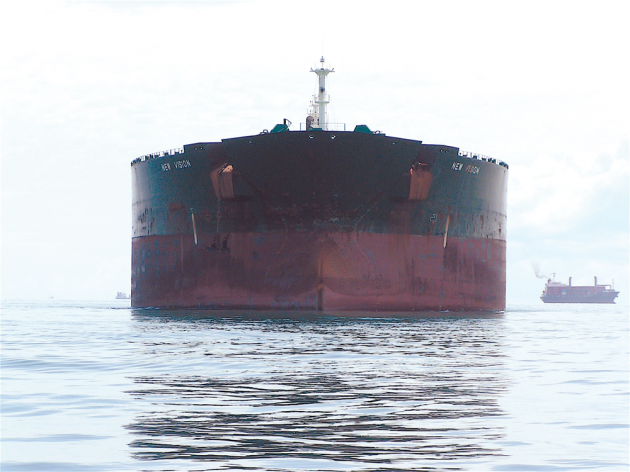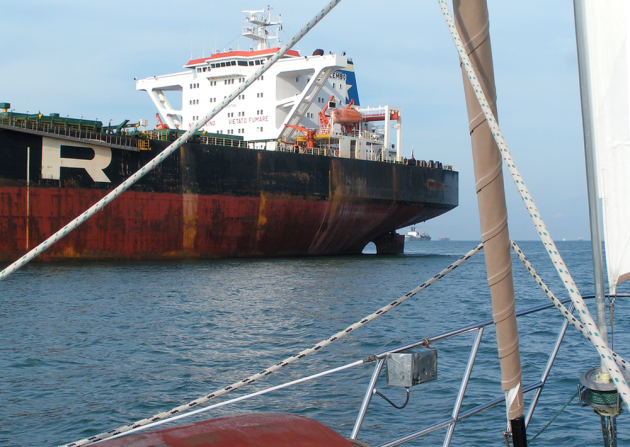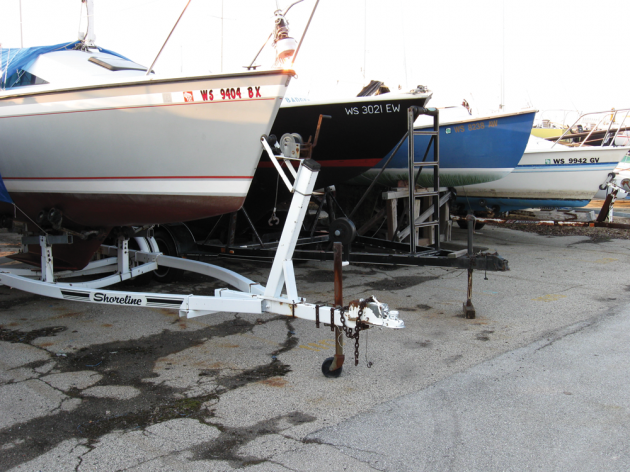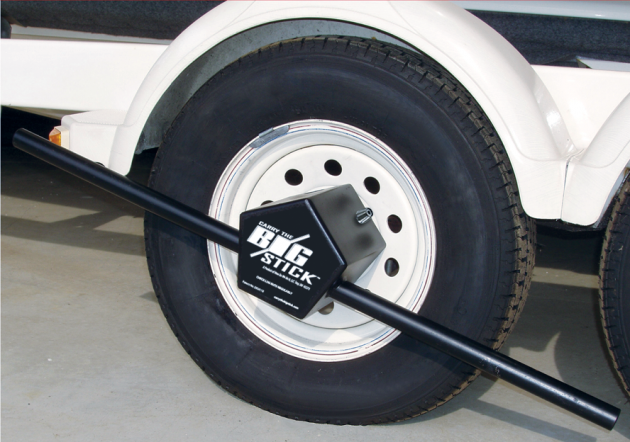Rules of the Road
2009 May 1
When sailing amongst the big ships, it helps to know how the traffic flows
An "avalanche of steel" might be a useful metaphor to remember for a sailboat encountering commercial shipping. Big ships don't make nimble turns or rapid stops, and to reverse direction is almost a morning's work. By comparison, a sailboat is a sports car. When considering the rules of the road, which in principle apply to boats and ships, my wife Irene and I, aboard our 39-foot cutter Moose, lean toward the virtues of modesty and discretion.

The International Regulations for Preventing Collisions at Sea, referred to as Colregs, are not a body of rules written to give one vessel tactical advantage over another. Instead, they are, as the name emphasizes, rules to be used with seamanlike common sense to prevent catastrophe. Frequently it will be the smaller private boat that is proactive in avoiding collisions. The following are some of the rules outlined in Colregs that apply to yachts, but I suggest you read the regulations in their entirety.

The most obvious rule is to always maintain a proper lookout: one person specifically responsible for collision-free sailing for a designated watch. But it can be so easy to get it wrong. For instance, on a sunny, clear Australian morning, a husband-and-wife crew aboard a 45-foot sailboat were motoring to sea down a wide, dredged channel marked with tall, 36-inch-diameter steel columns. They ducked below to fiddle with something and crashed terribly into one of the channel markers; so easy.

In avoiding collisions there are, naturally, rules that say who holds their course (the stand-on vessel) and who takes the avoiding maneuver (the give-way vessel). Imagine that it's night and you have on your red and green sidelights and your white sternlight. The red and green lights illuminate sectors from dead ahead to 22 1/2 degrees aft of the beam, a sweep of 112 1/2 degrees each. The sternlight illuminates the remaining 135 degrees dead astern (see Fig. 1). These odd fractions of degrees linger on from the traditional system of reporting: "Sail, bearing two points on the starboard bow." In practice, you'd be quite safe imagining three equal sectors surrounding your boat: a red, a green and a white astern.

If a vessel approaches in the sector of the red (port) sidelight, it is required to avoid you; you are the stand-on vessel. Likewise, a vessel approaching to overtake from behind, in the white light sector, must stay clear of you. However, a vessel converging from the right side has right of way; you are now the give-way vessel.
When the helmsperson observes a converging vessel he or she must first decide if there is a risk of collision. Then he or she must determine whether or not they are the give-way vessel. And finally, what action must be taken to avoid a collision is decided. Taking three or four bearings on the converging vessel over a few minutes and having them remain constant means that a collision is in the making. You can take a rudimentary bearing by leaning your head against, for example, the bimini frame and observing the converging vessel in line with a stay. Repeat this a couple of minutes later and see if the ship is still behind the stay.
Let's imagine the ship has remained on a constant bearing, it's approaching from about 90 degrees on your starboard side and it's about two miles away. This would not be a good time for coffee. In the open sea there is little reason for this ship to alter course. It may or may not have the radar turned on and the officer on watch may be having a look around or he may be studying toward career advancement. I would immediately and substantially alter course, and perhaps speed, to allow the ship a wide and clear path to pass in front of me.
Interestingly, I would do the same if I were the stand-on vessel, only I would establish VHF contact. Having an Automatic Identification System transponder (which announces the name, heading and speed of oncoming commercial shipping) would help in hailing the ship on Channel 16 to alert it to your position and your intentions to alter course. The ships we've contacted have generally been helpful and professional. Never try to cross a ship's bow. Several years ago, in the Straits of Gibraltar, I learned that they are deceptively fast.
In coastal waters you will have to remember that ships are often constrained to channels by their draft and to Traffic Separation Schemes by regulations. When we ran up the Straits of Malacca at night we used the chartplotter to hug the edge of the shipping lanes. Ships would never be outside of them and fishermen would never set nets in them. Bear in mind, however, that few Asian fishermen have chartplotters and that a rogue coastal tanker will happily run down, just outside, the up-going lane because it's shorter. A good watchkeeper has to think outside the box.
This is also true regarding lights. A ship underway will show red and green sidelights, a white sternlight and two white masthead lights visible through 225 degrees forward, with the aft distinctly higher than the forward. If it's constrained by draft it will show three all-around red lights on the after mast, in addition to the above. A tug with a tow should show two white masthead lights, sidelights, sternlight and a yellow towing light. Tugs cross the shipping lanes in the Straits of Malacca showing running lights and three yellow lights; the tow will often be sneaking along a quarter-mile back and unlit except for a solar garden lamp on the stern. You learn this system quickly.
Heavy traffic
Let me share an anecdote regarding the Singapore Straits. The straits are the busiest concentration of shipping in the world. All the tankers, bulk carriers and stacked-up container ships coming out of the South China Sea meet the torrent of shipping coming down the Straits of Malacca at Singapore. We had come up from Indonesia and had to negotiate that river of ships. I had been having ominous dreams about the running of the bulls in Pamplona.
What actually happens in the Singapore Straits is something like this: Legions of opposing shipping are marshaled into two separation zones, simplistically east- and west-going. There is also a buffer corridor between the two zones. Irene wondered if this might have been thoughtfully created as a sanctuary for huddled yachts. Within each of the separation zones ships proceed in the same direction, but at different speeds, sometimes passing one another, and sometimes forming cliques, three or four abreast. Frequently the traffic will pass at a rate of five ships per minute. On both sides of the zones, but especially on the Singapore side, are specified anchorages-anchorages for tankers, for LPG carriers, for ships laden with explosives and even for warships; whole series of volatile little communities. Running between these anchorages and the separation zones are arterial "fairways" from which shipping may suddenly emerge or, conversely, peel off into.
Our strategy was simple: make no contact, in both senses. Calling a ship on VHF would only create immense confusion in a stream of shipping that really had little or no possibility to alter course. We would be like a small, furry animal sharing a jungle trail with a large family of elephants.
Our tactics the next morning were equally simple. We never attempted to cross in front of a ship. We crossed the separation lines at the prescribed 90 degrees and aimed our bow at the Plimsoll mark in the center of the nearest ship. As we came closer to the ship we would alter course toward its stern and nip across his wake.
It was all going remarkably well. We found that the entire process was manageable because we broke it down into bite-sized pieces. We had a tentative plan for the next three ships-most of the time. I didn't mind getting sunburned as I stood on the foredeck calling the shots back to Irene. There were a couple of ships that had a narrow lateral separation with their neighbors and they squeezed us, and there were "small" guys who hid opportunistically behind tankers, but in general it was a benign crossing-until the end.
On the far northern side of the westbound lane was a tanker. It was red-ochre and resembled a mountain range. The windows along his bridge appeared as thin as a pencil line. I had been aware of him peripherally and he had been slowing for half an hour. He would be our last separation zone ship. I saw that the trees on the distant shore were no longer disappearing behind his massive bow. He was dead in the water, one o'clock on our starboard bow. Then his starboard anchor lowered a third of the way to the water.
"We're going to pass in front of him," I called to Irene. We held our course and at 6 knots drew up to the awesome hulk. Just as we were fully committed, a sonorous, sobering blast came from the ship's foghorn. A small curl of water on his bulbous bow grew into a smiling wave. We took the engine into rpm that were actively discouraged in the owner's manual and cut an escape across his 100-foot beam.
That was certainly exciting, I thought. But, after a moment's reflection, I laughed. The ship had no apparent reason or intention to get under way just as poor Moose went under her bows. I think the prospect of seeing a yacht in full flight had the people on the bridge incontinent with laughter.
An "avalanche of steel" might be a useful metaphor to remember for a sailboat encountering commercial shipping. Big ships don't make nimble turns or rapid stops, and to reverse direction is almost a morning's work. By comparison, a sailboat is a sports car. When considering the rules of the road, which in principle apply to boats and ships, my wife Irene and I, aboard our 39-foot cutter Moose, lean toward the virtues of modesty and discretion.

The International Regulations for Preventing Collisions at Sea, referred to as Colregs, are not a body of rules written to give one vessel tactical advantage over another. Instead, they are, as the name emphasizes, rules to be used with seamanlike common sense to prevent catastrophe. Frequently it will be the smaller private boat that is proactive in avoiding collisions. The following are some of the rules outlined in Colregs that apply to yachts, but I suggest you read the regulations in their entirety.

The most obvious rule is to always maintain a proper lookout: one person specifically responsible for collision-free sailing for a designated watch. But it can be so easy to get it wrong. For instance, on a sunny, clear Australian morning, a husband-and-wife crew aboard a 45-foot sailboat were motoring to sea down a wide, dredged channel marked with tall, 36-inch-diameter steel columns. They ducked below to fiddle with something and crashed terribly into one of the channel markers; so easy.

In avoiding collisions there are, naturally, rules that say who holds their course (the stand-on vessel) and who takes the avoiding maneuver (the give-way vessel). Imagine that it's night and you have on your red and green sidelights and your white sternlight. The red and green lights illuminate sectors from dead ahead to 22 1/2 degrees aft of the beam, a sweep of 112 1/2 degrees each. The sternlight illuminates the remaining 135 degrees dead astern (see Fig. 1). These odd fractions of degrees linger on from the traditional system of reporting: "Sail, bearing two points on the starboard bow." In practice, you'd be quite safe imagining three equal sectors surrounding your boat: a red, a green and a white astern.

If a vessel approaches in the sector of the red (port) sidelight, it is required to avoid you; you are the stand-on vessel. Likewise, a vessel approaching to overtake from behind, in the white light sector, must stay clear of you. However, a vessel converging from the right side has right of way; you are now the give-way vessel.
When the helmsperson observes a converging vessel he or she must first decide if there is a risk of collision. Then he or she must determine whether or not they are the give-way vessel. And finally, what action must be taken to avoid a collision is decided. Taking three or four bearings on the converging vessel over a few minutes and having them remain constant means that a collision is in the making. You can take a rudimentary bearing by leaning your head against, for example, the bimini frame and observing the converging vessel in line with a stay. Repeat this a couple of minutes later and see if the ship is still behind the stay.
Let's imagine the ship has remained on a constant bearing, it's approaching from about 90 degrees on your starboard side and it's about two miles away. This would not be a good time for coffee. In the open sea there is little reason for this ship to alter course. It may or may not have the radar turned on and the officer on watch may be having a look around or he may be studying toward career advancement. I would immediately and substantially alter course, and perhaps speed, to allow the ship a wide and clear path to pass in front of me.
Interestingly, I would do the same if I were the stand-on vessel, only I would establish VHF contact. Having an Automatic Identification System transponder (which announces the name, heading and speed of oncoming commercial shipping) would help in hailing the ship on Channel 16 to alert it to your position and your intentions to alter course. The ships we've contacted have generally been helpful and professional. Never try to cross a ship's bow. Several years ago, in the Straits of Gibraltar, I learned that they are deceptively fast.
In coastal waters you will have to remember that ships are often constrained to channels by their draft and to Traffic Separation Schemes by regulations. When we ran up the Straits of Malacca at night we used the chartplotter to hug the edge of the shipping lanes. Ships would never be outside of them and fishermen would never set nets in them. Bear in mind, however, that few Asian fishermen have chartplotters and that a rogue coastal tanker will happily run down, just outside, the up-going lane because it's shorter. A good watchkeeper has to think outside the box.
This is also true regarding lights. A ship underway will show red and green sidelights, a white sternlight and two white masthead lights visible through 225 degrees forward, with the aft distinctly higher than the forward. If it's constrained by draft it will show three all-around red lights on the after mast, in addition to the above. A tug with a tow should show two white masthead lights, sidelights, sternlight and a yellow towing light. Tugs cross the shipping lanes in the Straits of Malacca showing running lights and three yellow lights; the tow will often be sneaking along a quarter-mile back and unlit except for a solar garden lamp on the stern. You learn this system quickly.
Heavy traffic
Let me share an anecdote regarding the Singapore Straits. The straits are the busiest concentration of shipping in the world. All the tankers, bulk carriers and stacked-up container ships coming out of the South China Sea meet the torrent of shipping coming down the Straits of Malacca at Singapore. We had come up from Indonesia and had to negotiate that river of ships. I had been having ominous dreams about the running of the bulls in Pamplona.
What actually happens in the Singapore Straits is something like this: Legions of opposing shipping are marshaled into two separation zones, simplistically east- and west-going. There is also a buffer corridor between the two zones. Irene wondered if this might have been thoughtfully created as a sanctuary for huddled yachts. Within each of the separation zones ships proceed in the same direction, but at different speeds, sometimes passing one another, and sometimes forming cliques, three or four abreast. Frequently the traffic will pass at a rate of five ships per minute. On both sides of the zones, but especially on the Singapore side, are specified anchorages-anchorages for tankers, for LPG carriers, for ships laden with explosives and even for warships; whole series of volatile little communities. Running between these anchorages and the separation zones are arterial "fairways" from which shipping may suddenly emerge or, conversely, peel off into.
Our strategy was simple: make no contact, in both senses. Calling a ship on VHF would only create immense confusion in a stream of shipping that really had little or no possibility to alter course. We would be like a small, furry animal sharing a jungle trail with a large family of elephants.
Our tactics the next morning were equally simple. We never attempted to cross in front of a ship. We crossed the separation lines at the prescribed 90 degrees and aimed our bow at the Plimsoll mark in the center of the nearest ship. As we came closer to the ship we would alter course toward its stern and nip across his wake.
It was all going remarkably well. We found that the entire process was manageable because we broke it down into bite-sized pieces. We had a tentative plan for the next three ships-most of the time. I didn't mind getting sunburned as I stood on the foredeck calling the shots back to Irene. There were a couple of ships that had a narrow lateral separation with their neighbors and they squeezed us, and there were "small" guys who hid opportunistically behind tankers, but in general it was a benign crossing-until the end.
On the far northern side of the westbound lane was a tanker. It was red-ochre and resembled a mountain range. The windows along his bridge appeared as thin as a pencil line. I had been aware of him peripherally and he had been slowing for half an hour. He would be our last separation zone ship. I saw that the trees on the distant shore were no longer disappearing behind his massive bow. He was dead in the water, one o'clock on our starboard bow. Then his starboard anchor lowered a third of the way to the water.
"We're going to pass in front of him," I called to Irene. We held our course and at 6 knots drew up to the awesome hulk. Just as we were fully committed, a sonorous, sobering blast came from the ship's foghorn. A small curl of water on his bulbous bow grew into a smiling wave. We took the engine into rpm that were actively discouraged in the owner's manual and cut an escape across his 100-foot beam.
That was certainly exciting, I thought. But, after a moment's reflection, I laughed. The ship had no apparent reason or intention to get under way just as poor Moose went under her bows. I think the prospect of seeing a yacht in full flight had the people on the bridge incontinent with laughter.

Comments